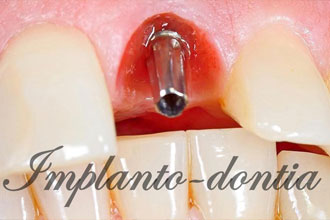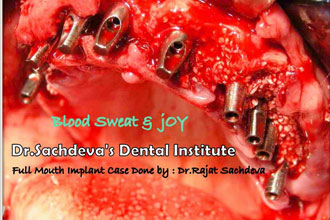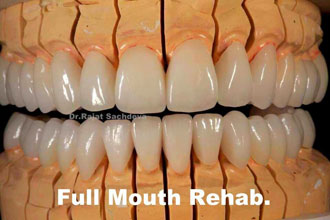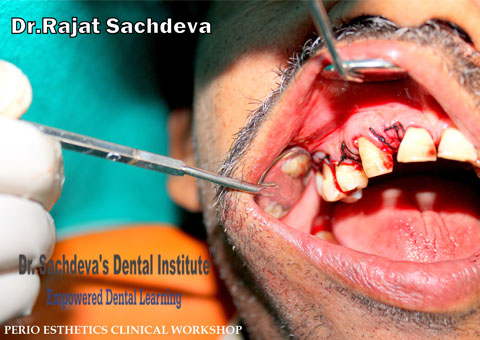Multiple Tooth Implants
Ask a Question to Our Dentist
Multiple Tooth Implants
What are Multiple Tooth Implants?
Multiple implants are indicated when more than one tooth is missing or in need of extraction and the surrounding teeth are healthy. There are several options for restoring individual teeth, but the implant option is the only treatment which provides a solution for the missing or damaged teeth without compromising the healthy teeth.
The dental implants used by most dental implant specialists today are root-form implants. Translated, they are substitute tooth roots, used to replace the natural tooth roots in areas of the mouth where teeth are missing. It is vitally important to replace the tooth root and not just the visible part of the tooth (crown) because the natural tooth roots, which are embedded in the bone, preserve the bone.
When missing tooth roots are not restored by implants, the bone that previously supported those teeth “melts away” or deteriorates. This process is called bone resorption. The impact of deteriorating bone from complete tooth loss includes collapsed facial profiles, lost lip support, increased wrinkles around the mouth and the appearance of a pointed nose and chin that are too close together.
A removable prosthesis, such as a partial denture, actually accelerates the bone resorption process, resulting in more rapid bone deterioration. In addition, the clasps which hold the partial denture in place put extreme pressure on the natural teeth they hook onto, loosening them and in many cases, eventually leading to the loss of those teeth. Most patients with partial dentures state that they are uncomfortable and they rarely wear them. Cemented bridges involve the filing and fixture of materials over the surfaces of adjacent teeth. In addition to bone loss, cemented bridges cause decay and shadowing under the gums.
The bone can be preserved by replacing missing tooth roots with multiple teeth implants and the existing teeth can be left alone. Since the bone actually forms a strong bond to the implants, they can serve the same functions as natural tooth roots: a strong foundation for biting and chewing and stimulation for the bone to hold it in place. Dental implants are small and made of titanium, a biocompatible material that is not rejected by the body. With an overall success rate of 95% and over, with an additional 50+ years of clinical research, dental implants have the best long-term prognosis of any method of tooth replacement.
The advantages of replacing multiple missing teeth with implant supported bridges:
Multiple Teeth Implants preserve the integrity of facial structures.
By preventing the bone resorption that would normally occur with the loss of teeth, the facial structures remain intact. This is particularly important when multiple teeth are missing, as the lower one-third of the face collapses if implants are not placed to preserve the bone. By replacing the entire tooth, including the root, it is possible to replicate the function of natural teeth, with a strong, stable foundation that allows comfortable biting and chewing. In addition, nothing in the mouth looks, or feels artificial.
Your smile is improved when replacement teeth look more like natural teeth.
Even when only one tooth is missing, long term esthetics are usually much better with an implant supported replacement tooth than with a traditional tooth supported bridge. This is particularly important in the front of your mouth, where preventing a visible bone defect is critical for natural appearance.
Adjacent teeth are not compromised to replace missing teeth.
Tooth replacement with traditional tooth-supported bridges requires grinding down the teeth adjacent to the missing teeth, so that the bridge can be cemented onto them. This tooth structure can never be replaced and the long-term health of these teeth is compromised. Partial dentures have clasps that hook onto adjacent teeth, putting pressure on them as the partial rocks back and forth. Eventually these teeth can loosen and come out as a result of this pressure. Replacing missing teeth with implant supported crowns/bridges does not involve the adjacent natural teeth, so they are not compromised, or damaged.
Overall quality of life is enhanced with replacement teeth that look, feel and function like natural teeth.
With implant supported replacement teeth, the appearance of the smile is more natural and the teeth function more like natural teeth. The result is increased comfort and confidence when smiling, speaking, and eating. If dentures and partials are replaced with implant supported teeth, the overall enhancement in quality of life is even more significant, with an ability to eat all types of foods, elimination of messy adhesives, and improved speech, comfort and appearance.
Convenient oral hygiene.
It is much easier to care for an implant supported crown, which can be cleaned like a natural tooth. In comparison, a tooth supported bridge requires the use of a floss threader for proper cleaning. It is also more convenient to clean a full set of implant supported replacement teeth than a traditional denture.
Improved appearance.
Since implants preserve bone, preventing deterioration of the facial structures, appearance is improved. Collapse of the lower one-third of the face caused by complete tooth loss can be visually corrected and the remaining bone preserved. The appearance of wrinkles around the mouth caused by posterior bite collapse, or complete facial structure collapse is virtually eliminated.
Restored self-esteem and renewed self-confidence.
Many of the people who now enjoy the benefits of implant supported replacement teeth state that their self esteem and self confidence have been restored as a result of improved appearance, function, comfort, and health.

- drrajatsachdeva
- Treatment
- Cosmetic Dentistry, Laser Dentistry, Dental Clinic in Delhi, Kids Dentistry
latest Posts
Stay up to date with all our latest news and launches.





